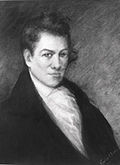Top Qs
Timeline
Chat
Perspective
North Carolina's 12th congressional district
U.S. House district for North Carolina From Wikipedia, the free encyclopedia
Remove ads
North Carolina's 12th congressional district is a congressional district located mostly in Charlotte as well as surrounding areas in Mecklenburg County represented by Democrat Alma Adams. Prior to the 2016 elections, it was a gerrymandered district located in central North Carolina that comprised portions of Charlotte, Winston-Salem, Greensboro, Lexington, Salisbury, Concord, and High Point.[3] With a Cook Partisan Voting Index of D+24, it is the most Democratic district in North Carolina.
It was one of two minority-majority Congressional districts created in the state in the 1990s. Between 2003 and 2013, there was a small plurality of white Americans in the district according to the 2000 United States census, although African Americans made up a comparable proportion of the voting population. As redrawn for the 2012 elections and under the lines used prior to the 2016 elections, the district had an African-American majority according to the 2010 United States census. The 12th district is the second most Democratic district in North Carolina, and it has never been represented by a Republican.
North Carolina had a twelfth seat in the House in the early nineteenth century (1803–1843) and in the mid-twentieth century (1943–1963). Most of the territory in the district's second incarnation is now in the 11th district.
Remove ads
History
Summarize
Perspective
The district was re-established after the 1990 United States census, when North Carolina gained a House seat due to an increase in population. It was drawn in 1992 as one of two minority-majority districts, designed to give African-American voters (who comprised 22% of the state's population at the time) the chance to elect a representative of their choice; Section 2 of the Voting Rights Act prohibited the dilution of voting power of minorities by distributing them among districts so that they could never elect candidates of their choice.[4]
In its original configuration, the district had a 64 percent African-American majority in population. The district boundaries, stretching from Gastonia to Durham, were so narrow at some points that it was no wider than a highway lane. It followed Interstate 85 almost exactly.[5][6] One state legislator famously remarked, after seeing the district map, "if you drove down the interstate with both car doors open, you'd kill most of the people in the district."[7][8]
The United States Supreme Court ruled in Shaw v. Reno (1993) that a racial gerrymander may, in some circumstances, violate the Equal Protection Clause of the United States Constitution.
The state legislature defended the two minority-majority districts as based on demographics, with the 12th representing people of the interior Piedmont area and the 1st the Coastal Plain.[4] Subsequently, the 12th district was redrawn several times and was adjudicated in the Supreme Court on two additional occasions.[4] The version created after the 2000 census was approved by the U.S. Supreme Court in Hunt v. Cromartie. The district's configuration dating from the 2000 census had a small plurality of whites, and it was changed only slightly after the 2010 census. African Americans make up a large majority of registered voters and Hispanics constitute 7.1% of residents.
On February 5, 2016, U.S. Circuit Judge Roger L. Gregory ruled that the district, along with North Carolina's 1st congressional district,[9] must be redrawn from its post-2010 configuration,[10] and that race could not be a mitigating factor in drawing the district.[11] This decision, in the case of Cooper v. Harris, was subsequently upheld 5−3 by the U.S. Supreme Court in an opinion by Justice Elena Kagan on May 22, 2017.[12] In the opinion, Justice Kagan noted that this marked the fifth time the 12th district had appeared before the Supreme Court, following Shaw v. Reno and Hunt v. Cromartie which had both been heard twice before the Court.[13]
In all of its configurations, it has been a Democratic stronghold. Its previous incarnation was dominated by black voters in Charlotte, Greensboro, and Winston-Salem. The redrawn map made the 12th a compact district comprising nearly all of Mecklenburg County, except the southeast quadrant. Due to Charlotte's heavy swing to the Democrats in recent years, the reconfigured 12th is no less Democratic than its predecessor.
On February 23, 2022, the North Carolina Supreme Court had approved a new map only used for the 2022 United States House of Representatives elections which had changed the 12th district boundaries to include the northern half of Mecklenburg County, including most of Uptown, along with eastern Cabarrus County.[14]
On October 25, 2023, the North Carolina General Assembly redrew and approved a new congressional map for the 2024 election, and shifting the district to only Mecklenburg county.
Remove ads
Counties and communities
For the 119th and successive Congresses (based on the districts drawn following a 2023 legislative session), the district contains all or portions of the following counties and communities.[15][16][17]
Recent election results from statewide races
Remove ads
List of members representing the district
Summarize
Perspective
Remove ads
Past election results
2002
2004
2006
2008
2010
2012
2014 special election
2014
2016
2018
2020
2022
2024
Remove ads
See also
References
Works cited
Wikiwand - on
Seamless Wikipedia browsing. On steroids.
Remove ads



















